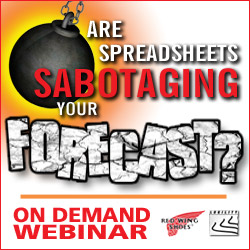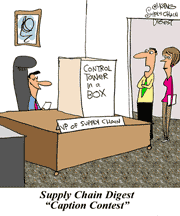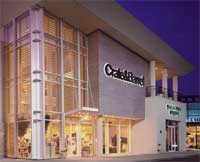 |
November 1, 2013 - Supply Chain Flagship Newsletter |
 |
| THIS WEEK'S SPONSOR: LOGILITY |
 |
On Demand Webinar: |
 |
|
|||||||||||||||||||||||||||||||||||||||||||||||||||||||||||||||||||||||||||||
Trip Report - CSCMP 2013 Part 2
|
||||||||||||||||||||||||||||||||||||||||||||||||||||||||||||||||||||||||||||||
| GILMORE SAYS: |
"Whirlpool has set up a structure so that the hard core demand planners are well insulated from any political pressures or lobbying within the company" WHAT DO YOU SAY? |
I will first note that South Africa’s Abre’ Pienarr won the Distinguished Service Award, which it is fair to say is the supply chain industry's most prestigious honor. To be frank, I had not heard of Pienarr, but he clearly has a long and noteworthy career as an academic and practitioner, authoring a slew of papers and books, including “ERP for Executives.”
He made two insightful comments during his nicely brief award acceptance speech: (1) today, identifying the right solution is usually much easier than getting different individuals and trading partners, with their own interests and perspectives, to really go along with it; and (2) the questions in supply chain don't change all that much, but the correct answers do more and more frequently.
Ok, on to the sessions. I attended an excellent presentation Monday led in solo fashion by Tony Nikolai of Whirlpool, on getting the politics out of the S&OP process. In too many companies, he said, the data doesn't always win the discussion - you need to build a culture where the data does consistently drive S&OP decisions.
Whirlpool has set up a structure so that the hard core demand planners are well insulated from any political pressures or lobbying within the company. That in my view can only be accomplished within a culture where company executives want the real, unvarnished numbers on which to base plans and decisions (including those, of course, that might then change the forecast).
The culture has also been developed so that it constantly forces participants back to the data, making it very difficult to make decisions that are at odds with the data - I wish I could say that is how the S&OP process worked at all companies. There is also a hard core mindset around rapid decision-making. If you miss an S&OP-related meeting at Whirlpool, decisions for your functional area are likely to be made for you, so the process keeps moving.
There was a lot more, but hopefully you get the idea. This approach has actually simplified the entire process, and enabled Whirlpool to operate with just seven demand planners, down from 18 earlier. But about 125 people participate in S&OP there across its four main product platforms.
I am going to add one more point here, and that is that Whirlpool isn’t a fan of the "one number" forecast concept that has been so predominant in recent years. Nikolai said what Whirlpool really wants is a range of what demand is going to be, so it can successfully manage from the bottom to the top. I heard Jason Reiman of Hershey made some similar points in his S&OP presentation, which I was not able to attend. Interesting - more on this soon.
Earlier on Monday, I attended a pretty good panel discussion on how to manage 3PLs and the resulting global networks. Gartner’s Greg Aimi (a good friend of mine) started the discussion by noting that his research shows that most large companies are looking to reduce the total number of 3PLs they use, and have broader and deeper relationships with those that remain. He also said the continued growth in outsourcing levels means it will become vital to have talent that can define, contract and manage these outsourced networks, rather than possessing the deep functional skills in logistics that has traditionally been the model. That’s something to think about.
Reade Kidd, director on international logistics for Home Depot, had a number of interesting observations, including supporting the notion of fewer deeper 3PL relationships. He observed how much easier it was to technically integrate with a handful of providers versus a dozen or something, and ditto for communicating with them about strategies and where Home Depot wanted to go.
In general, he said, three is a good number of 3PLs to use in a given service area, providing an optimal balance between manageability and keeping the service providers competitive, although in some cases the company will use just two.
Keeping somewhat on the same track, I attended a "megasession" on the morning of the last day on the impact of mergers and acquisitions on the future of transportation and logistics. Unfortunately, the panel never really addressed that question (odd, actually), but had a number of interesting moments nonetheless.
Ray Greer, who now runs BNSF Logistics, noted that very tough US anti-corruption laws have been a big reason why no US-based company has emerged as a large, truly global 3PL such as Panalpina or Kuhne+Nagel. US laws are frankly inconsistent with how business gets done in some parts of the world, he said, and also inhibit acquisitions, as many foreign 3PLs may have some modest skeletons in their closets in this regard that a US-based don’t want to risk taking on. Many European and Asian providers do not have such high barriers.
Brad Jacobs, currently CEO of XPO Logistics and a serial entrepreneur and acquirer, is an example of what can be done. The company has gone from almost nothing a few years ago to what will soon be a billion dollar provider largely through acquisitions. This firm I have barely heard of says it is now number 1 in the US in home delivery and number 4 in freight brokerage, according to Jacobs, driven by a roll-up strategy.
John Anderson of Greenbriar Equity Group noted that politicians and others hoping for a lot of private money to come in to support US logistics infrastructure projects probably should look for other options. Such investments on average return about 8%, he said, with a lot of risk - and the big money can do a lot better elsewhere.
I also went to a panel discussion on Tuesday on so-called "big data" in the supply chain. This is a topic we just haven’t covered much in SCDigest, though I hope to rectify that soon. That is partly because what the term really means is still pretty elusive, if you ask me.
That perspective was supported by Kraft's Ron Volpe, who noted that was "big data" five years ago is now somehow "little data," and frankly the panel struggled a bit to shed additional light on the topic and offer practical, new (key word) supply chain applications.
Gary Whicker of JB Hunt did offer one solid example, and that was how the company took millions of data points from on-board recorders and GPS systems on its trucks and was able to model driver behaviors that could be correlated with accidents down the road (say entering off ramps at too high a speed).
Now, when it sees those patterns, it provides counseling to those drivers on avoiding those behaviors, and he says incidents at Hunt are down sharply as a result.
Kraft's Volpe said his company is pursuing the connections between say social media and other factors on consumer buying, but still has a way to go. This big data project may never pan out, he admits, but thinks the risk to a consumer goods company in not going down this path now are too great, because if someone cracks the code first and you are way behind, you will be at a considerable competitive disadvantage.
As an aside, my good friend David Simchi-Levi of MIT recently gave me another good big data example in prepping for an upcoming videocast we are broadcasting: sifting through mountains of data on suppliers and countries to find patterns that indicate risk has reached worrisome levels at some particular source. Only a computer and advanced analytics can look through all the data intelligently.
Ok, there were a few more sessions I attended but I am out of room. Look for more detailed articles on several of these sessions over the next few weeks, as well as summaries of several of the annual reports released at the conference as well (3PL Report, Trends and Issues in Logistics and Transportation, etc.).
Were you at CSCMP? What did you think or find interesting? Any reaction to Gilmore's summary? Let us know your thoughts at the Feedback section below.
| View Web/Printable Version of this Page |
|
|
|
YOUR FEEDBACK
We received some e-mails regarding how packaging design impacts sustainability. Some samples of this feedback are below.
Feedback - Packaging Megatrends
The "1.5 inch change" graphic is pretty dramatic, but I don't see the focus on "1.5 inch". There were changes to all of the unit load dimensions, but the biggest change was the elimination of a lot of air / dunnage in the outer case pack. They went from 30 cases of 4 each cartons to 75 cases of 4 each by improving the case pack. Package engineering and product engineering should be fully in lock-step and focused on both protecting the product and providing value to the retail and end customer. Apart from functionality and fit, consumers buy products that present well and are not broken.
Steve Murray
|
||
Wagner is 100% on target but like many packaging experts doesn't go deep enough into the freight component which is still the biggest cost bucket: 10X more impact than the box itself. Small package and LTL carriers are very sophisticated in relating packaging to freight efficiency so they weigh and measure many boxes they handle and adjust freight bills as a result...usually raising them. Also there is the aspect of dimensional weight which has become a bigger factor in ground shipments. Many companies still do not understand dimensional weight and how to reduce its impact on shipping cost. LTL carriers derive freight classes from the NMFC book which has about 150 pages of packaging rules that affect freight rates, yet I have dealt with many packaging engineers that do not even know about freight classes or how they relate to packaging. How can they possibly design the optimal distribution package if they do not have that knowledge?
Jack Ampuja |
||
SUPPLY CHAIN TRIVIA ANSWER
Q: What is the approximate current capacity of the global container shipping industry in terms of TEU (20-foot equivalent units)?
A: About 17.7 million TEU, according to Alphaliner, though of course that number is dynamic.
| © SupplyChainDigest™ 2003-2013. All Rights Reserved. SupplyChainDigest PO Box 714 Springboro, Ohio 45066 |
POWERED BY: XDIMENSION
|








